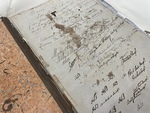1
Facsimile
Transcription
Chambigne 2nd July / 54.
Sir,
I do myself the honor to
acknowledge the receipt of your letter
of the 2nd Ultimo, informing me that the
sum of £167 - 8 - 6. had been placed to
my credit on public account in the Bank
of New South Wales, Sydney.
I have taken on a lad named
Robert as a trooper, he is a native of
Cassilis and particularly steady and
active. He has already learned the drill.
If you approve of this step I trust
you will let me know, in time to place
his name on the pay abstracts for this
quarter.
I have the honor to remain
Sir,
Your Obdt Servt
[signed] E V Morisset
Lieut. Native Police
Frederick Walker Esqr.
Commandant Native Police.
Notes and Questions
Please sign in to write a note for this page
Please advise the correct method for transcribing the currency as written in this letter. Also, please advise the preferred transcription method for abbreviations such as "Obdt. Servt." where a superscript 't' sits above a period/dot. Thanks!
I have been using the "copy-and-paste" method of rendering the British Pound symbol for some time. The green formatting allows you to represent the superscript abbreviations for dates, names, letter sign-offs, etc. Some sites (like the State Library of Queensland) don't allow its usage, because it is too hard for them to upload the completed document into their final online format. So far, the Qld State Archives haven't forbidden its usage - although they might now!
Thanks for not spoiling my fun, Qld Frontier Conflict. I enjoy using the green formatting, especially for underlining and showing words written above other words in a sentence.
Hi Cursivefancier, what coding method do you use to show "words written above other words in a sentence"? I used word when I came across one of those and wondered if there is a better way.
It won't allow me to write the formatting in the notes here, but it's the two little sideways "v" symbols on the keyboard (above the comma and full-stop - period symbols) with the word "add" between them - before the word you are adding above - followed by sideways "v" (above the comma), forward slash, add, sideways "v" [above the full-stop). Hope that makes sense. I just learnt how to do it by looking at other transcribers' work, while on the Library of California site a couple of years ago. There is also "s" with the sideways "v" symbol etc (for delete, or "strike out") and "u" for underline. I don't know anything about actual coding.
Those 'v' brackets are called chevron brackets (or angle brackets). The code being used is called hypertext markup language or .html - This program language is universally rendered by browsers (chrome, edge, safari etc). This allows various methods to read the document. For example, the accessibility acts of many countries when conformed with permits text-to-voice interpretation for those who are visually impaired. Proprietarial coding is used for various document storage systems and if that is the end destination there are unique codes that vary. BTW, I find transcribing these documents a favourite past time that is so very interesting.
